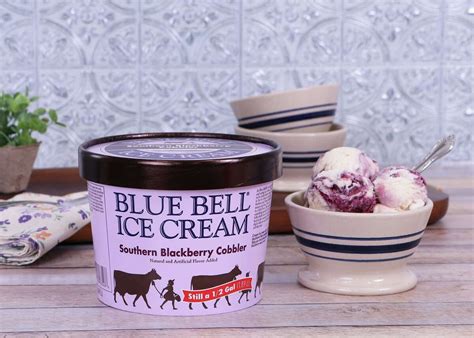
Blue Bell fans, rejoice! The iconic ice cream maker has announced the return of its beloved Dutch Chocolate flavor to stores, ending a five-year hiatus and satisfying cravings across the nation. The flavor, described by many as an “all-time favorite,” is now available in half-gallon and pint sizes, bringing back a taste of nostalgia for loyal customers.
Blue Bell Creameries, based in Brenham, Texas, confirmed the return, stating that Dutch Chocolate is back by popular demand. “We are excited to bring back a flavor that so many of our consumers have requested,” said a Blue Bell spokesperson. The decision to reinstate Dutch Chocolate underscores the company’s commitment to listening to its customers and providing the flavors they love. The flavor’s return has sparked considerable excitement on social media, with Blue Bell enthusiasts sharing their delight and anticipation.
The absence of Dutch Chocolate from Blue Bell’s lineup was keenly felt by many. The company regularly rotates flavors, introducing new creations while occasionally retiring others to make room. While this strategy keeps the selection fresh and innovative, some retirements, like that of Dutch Chocolate, leave a significant void for devoted fans. The consistent requests and social media campaigns for its return highlight the special place this particular flavor holds in the hearts of Blue Bell consumers.
Dutch Chocolate stands out due to its rich, intense cocoa flavor profile. The ice cream is crafted using a blend of high-quality cocoa that creates a deep, dark chocolate experience. This distinguishes it from more standard chocolate ice creams, offering a more sophisticated and decadent treat. The smooth and creamy texture further enhances its appeal, making it a satisfying choice for chocolate lovers. Its return to shelves marks a significant win for those who have missed its unique taste.
The return of Dutch Chocolate also carries symbolic weight for Blue Bell. After facing significant challenges several years ago, including a listeria outbreak that led to a complete recall of its products, the company has worked diligently to rebuild its reputation and regain consumer trust. Bringing back a popular, well-loved flavor signifies a return to normalcy and a renewed focus on delivering the high-quality ice cream that customers expect.
This event isn’t just about ice cream; it’s about tradition, nostalgia, and the simple pleasures in life. For many, Blue Bell represents a taste of home and happy memories. The return of Dutch Chocolate is a reminder of those comforting moments and a celebration of a brand that has been a part of countless family gatherings and special occasions. As Blue Bell continues to navigate the competitive ice cream market, listening to its customers and honoring its heritage will remain crucial to its ongoing success.
A History of Blue Bell Creameries
Blue Bell Creameries has a storied history that spans over a century. Founded in 1907 as the Brenham Creamery Company, it originally produced butter before venturing into ice cream production a few years later. The company’s name was changed to Blue Bell Creameries in 1930, inspired by the native Texas bluebell wildflower, symbolizing the company’s commitment to local roots and natural ingredients.
Throughout the 20th century, Blue Bell steadily grew in popularity, expanding its distribution throughout Texas and neighboring states. The company’s commitment to quality, using fresh milk and cream sourced from local dairies, set it apart from larger national brands. Blue Bell’s ice cream became synonymous with Texas, earning a reputation for its creamy texture and rich, authentic flavors.
The company’s growth was not without its challenges. In 2015, Blue Bell faced a significant crisis when a listeria outbreak was linked to its products. This led to a complete recall of all Blue Bell ice cream and a temporary shutdown of its production facilities. The incident severely impacted the company’s reputation and financial stability.
In the aftermath of the crisis, Blue Bell implemented extensive safety measures and underwent rigorous inspections to ensure the safety of its products. The company worked closely with regulatory agencies to address the issues that led to the outbreak and implemented enhanced testing and sanitation protocols. This period marked a significant turning point for Blue Bell, forcing the company to re-evaluate its operations and prioritize food safety above all else.
Blue Bell’s resilience in the face of adversity is a testament to its strong brand loyalty and the dedication of its employees. The company’s commitment to rebuilding trust with its customers was evident in its transparent communication and proactive efforts to address the concerns raised by the outbreak. The return of Dutch Chocolate is a symbol of this recovery, demonstrating Blue Bell’s ongoing commitment to delivering the flavors that customers love while upholding the highest standards of safety and quality.
The Impact of Flavor Rotation Strategies
Blue Bell’s decision to rotate flavors is a common practice in the ice cream industry. This strategy allows companies to keep their product lines fresh and exciting, appealing to a wide range of tastes and preferences. By introducing new and limited-edition flavors, Blue Bell can generate buzz and attract new customers while also satisfying the cravings of long-time fans.
However, flavor rotation also carries the risk of disappointing customers who become attached to particular flavors. The decision to retire a beloved flavor can lead to disappointment and even outrage, as evidenced by the social media campaigns calling for the return of Dutch Chocolate. Companies must carefully weigh the benefits of flavor rotation against the potential backlash from loyal customers.
Blue Bell’s approach to flavor rotation appears to be data-driven, with the company closely monitoring sales and customer feedback to inform its decisions. The return of Dutch Chocolate suggests that Blue Bell is responsive to customer demand and willing to bring back popular flavors when there is sufficient interest. This approach helps to balance the need for innovation with the desire to satisfy the preferences of its core customer base.
The decision to bring back a retired flavor can also be a strategic marketing move. By announcing the return of Dutch Chocolate, Blue Bell is generating positive publicity and reminding customers of its commitment to quality and customer satisfaction. This can help to strengthen the company’s brand image and drive sales.
The Science Behind Chocolate Ice Cream
Chocolate ice cream, like Dutch Chocolate, is a complex combination of ingredients that interact in fascinating ways to create its unique flavor and texture. The key ingredient, of course, is cocoa, which provides the distinctive chocolate flavor. The type and quality of cocoa used can significantly impact the final product. Dutch-processed cocoa, which is treated with an alkaline solution to neutralize its acidity, is often used in Dutch Chocolate ice cream. This process results in a smoother, less bitter flavor.
The fat content of the ice cream also plays a crucial role in its texture and mouthfeel. Milk and cream provide the necessary fat, which helps to create a rich, creamy consistency. Sugar is added to sweeten the ice cream and also helps to lower its freezing point, preventing the formation of large ice crystals.
Emulsifiers, such as egg yolks or stabilizers, are often added to ice cream to improve its texture and prevent separation. These ingredients help to bind the water and fat molecules together, creating a smooth, homogenous mixture. Stabilizers, such as guar gum or carrageenan, can also help to prevent ice crystal growth during storage, maintaining the ice cream’s creamy texture over time.
The freezing process is critical to the final product. As the ice cream mixture is churned and frozen, air is incorporated, creating a light, airy texture. The amount of air incorporated, known as overrun, can vary depending on the brand and type of ice cream. Higher overrun results in a lighter, less dense product.
The Competitive Landscape of the Ice Cream Market
The ice cream market is highly competitive, with a wide range of brands vying for consumers’ attention. From mass-produced national brands to small-batch artisanal producers, the ice cream industry offers a diverse array of choices. Blue Bell occupies a unique position in this market, with a strong regional presence and a loyal following in the Southern United States.
Major national brands, such as Häagen-Dazs, Ben & Jerry’s, and Breyers, dominate the market with their extensive distribution networks and marketing budgets. These brands offer a wide variety of flavors and product formats, catering to a broad range of consumer tastes.
In recent years, the artisanal ice cream market has also grown in popularity. Small-batch producers, often using locally sourced ingredients, offer unique and innovative flavors that appeal to consumers seeking a more premium and distinctive ice cream experience. These artisanal brands often emphasize quality and craftsmanship, setting themselves apart from mass-produced offerings.
Blue Bell’s success in the competitive ice cream market can be attributed to several factors, including its commitment to quality ingredients, its strong brand identity, and its loyal customer base. The company’s focus on regional flavors and traditions has also helped it to differentiate itself from national brands.
The return of Dutch Chocolate is a testament to Blue Bell’s ability to listen to its customers and respond to their preferences. By bringing back a beloved flavor, Blue Bell is reinforcing its commitment to customer satisfaction and strengthening its brand loyalty.
The Future of Blue Bell Creameries
Looking ahead, Blue Bell Creameries faces both opportunities and challenges in the evolving ice cream market. The company must continue to innovate and adapt to changing consumer tastes while also maintaining its commitment to quality and safety.
One key area of focus for Blue Bell will be expanding its distribution network. While the company has a strong presence in the Southern United States, it has limited distribution in other parts of the country. Expanding into new markets could help Blue Bell to reach a wider audience and increase its overall sales.
Another important area of focus will be product innovation. Blue Bell must continue to develop new and exciting flavors that appeal to a wide range of consumers. This could involve experimenting with new ingredients, flavor combinations, and product formats.
Sustainability is also becoming an increasingly important consideration for consumers. Blue Bell may need to explore more sustainable sourcing and production practices to appeal to environmentally conscious consumers. This could involve using locally sourced ingredients, reducing its carbon footprint, and minimizing waste.
Despite the challenges, Blue Bell Creameries has a bright future. The company’s strong brand identity, loyal customer base, and commitment to quality ingredients position it well for continued success in the competitive ice cream market. The return of Dutch Chocolate is a positive sign, demonstrating Blue Bell’s ability to listen to its customers and deliver the flavors they love. As long as Blue Bell remains true to its core values and continues to innovate, it will remain a beloved and iconic brand for generations to come.
Quotes from the Original Source:
- “We are excited to bring back a flavor that so many of our consumers have requested.” – Blue Bell Spokesperson.
Frequently Asked Questions (FAQ) about the Return of Blue Bell’s Dutch Chocolate:
Q1: Why was Dutch Chocolate discontinued in the first place?
A1: While Blue Bell didn’t explicitly state the reason for discontinuing Dutch Chocolate, the company regularly rotates flavors to keep its product line fresh and introduce new options. This means that some flavors are temporarily or permanently retired to make room for new creations. The specifics as to why Dutch Chocolate was removed from the line-up, as opposed to other flavors, were not disclosed.
Q2: Where can I buy Blue Bell’s Dutch Chocolate ice cream?
A2: Dutch Chocolate is now available in stores that sell Blue Bell ice cream. Check your local grocery stores, convenience stores, and other retailers that typically carry Blue Bell products. Its availability may vary depending on your location, so it’s always a good idea to check with your local stores first.
Q3: What sizes does Dutch Chocolate come in?
A3: Blue Bell’s Dutch Chocolate is available in both half-gallon and pint sizes, providing options for individuals and families alike.
Q4: Is this a limited-time offering, or will Dutch Chocolate be a permanent addition to Blue Bell’s flavor lineup?
A4: Blue Bell has not explicitly stated whether Dutch Chocolate’s return is permanent or a limited-time offering. Given the high demand and positive response, there’s a possibility it could become a permanent fixture. Consumers are encouraged to purchase it while it’s available, as Blue Bell’s flavor availability can change. Follow Blue Bell’s social media channels and website for any future updates.
Q5: How does Blue Bell’s Dutch Chocolate differ from other chocolate ice creams?
A5: Blue Bell’s Dutch Chocolate is known for its rich, intense cocoa flavor. This is achieved by using a blend of high-quality cocoa, often Dutch-processed, which gives it a deeper, less bitter chocolate taste compared to standard chocolate ice creams. The smooth and creamy texture further enhances the overall flavor profile, making it a distinct and highly sought-after chocolate ice cream option.









